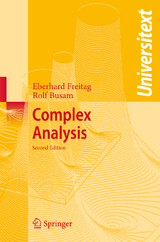Complex Analysis
Springer Berlin (Verlag)
978-3-540-93982-5 (ISBN)
The idea of this book is to give an extensive description of the classical complex analysis, here ''classical'' means roughly that sheaf theoretical and cohomological methods are omitted.
The first four chapters cover the essential core of complex analysis presenting their fundamental results. After this standard material, the authors step forward to elliptic functions and to elliptic modular functions including a taste of all most beautiful results of this field. The book is rounded by applications to analytic number theory including distinguished pearls of this fascinating subject as for instance the Prime Number Theorem. Great importance is attached to completeness, all needed notions are developed, only minimal prerequisites (elementary facts of calculus and algebra) are required.
More than 400 exercises including hints for solutions and many figures make this an attractive, indispensable book for students who would like to have a sound introduction to classical complex analysis.
For the second edition the authors have revised the text carefully.
Differential Calculus in the Complex Plane C.- Integral Calculus in the Complex Plane C.- Sequences and Series of Analytic Functions, the Residue Theorem.- Construction of Analytic Functions.- Elliptic Functions.- Elliptic Modular Forms.- Analytic Number Theory.- Solutions to the Exercises.
From the reviews:
"The guiding principle of the presentation of classical complex analysis is to proceed as quickly as possible to the central results while using a small number of notions and concepts from other fields. Thus the prerequisites for understanding this book are minimal; only elementary facts of calculus and algebra are required. ... Motivating introductions, more than four hundred exercises of all levels of difficulty with hints or solutions, historical annotations, and over 120 figures make the overall presentation very attractive." (L'Enseignement Mathematique, Vol. 52 (2), 2006)
"The first four chapters cover the essential core of complex analysis ... . The second part of the book is devoted to an extensive representation of the theory of elliptic functions ... . Interesting introductions, over four hundred exercises with hints or solutions, historical remarks, and over 120 figures make this book very appropriate and attractive for students at all levels." (F. Haslinger, Monatshefte für Mathematik, Vol. 149 (3), 2006)
"It is, in fact, a massive introduction to complex analysis, covering a very wide range of topics. ... This is the material that I like to cover in an undergraduate course. ... Theorems and proofs are clearly delimited, which many students find helpful. ... There are problems at the end of each section, and sketches of solutions are given ... . Overall, this is quite an attractive book." (Fernando Q. Gouvêa, MathDL, February, 2006)
From the reviews of the second edition:
"This introduction to complex analysis is fairly special, and ... unique within the existing related textbook literature. ... The authors present, apart from the standard material, a wide range of topics that are usually not covered by introductory texts ... . No doubt, this excellent, comprehensive, and nearly self-contained textbook on complex analysis deserves a wide international audience of readers, who willprofit a great deal from studying it." (Werner Kleinert, Zentralblatt MATH, Vol. 1167, 2009)
| Erscheint lt. Verlag | 15.4.2009 |
|---|---|
| Reihe/Serie | Universitext |
| Zusatzinfo | X, 532 p. 112 illus., 2 illus. in color. |
| Verlagsort | Berlin |
| Sprache | englisch |
| Maße | 155 x 235 mm |
| Gewicht | 795 g |
| Themenwelt | Mathematik / Informatik ► Mathematik ► Analysis |
| Schlagworte | Calculus • Complex Analysis • elliptic functions • Elliptic Modular Forms • Komplexe Analysis • Minimum • modular form • Residue Theorem |
| ISBN-10 | 3-540-93982-2 / 3540939822 |
| ISBN-13 | 978-3-540-93982-5 / 9783540939825 |
| Zustand | Neuware |
| Informationen gemäß Produktsicherheitsverordnung (GPSR) | |
| Haben Sie eine Frage zum Produkt? |
aus dem Bereich




